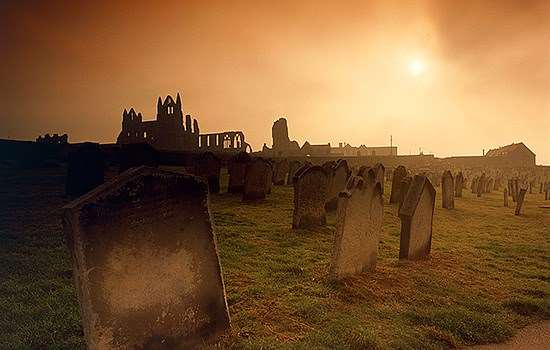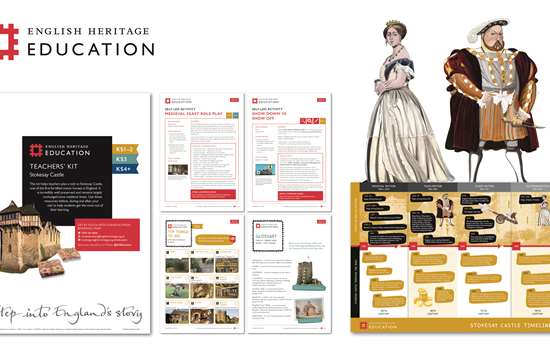Get to Grips with the Area
Archaeological excavations have shown that there was a settlement on the Whitby headland during the Bronze Age. It's also possible that there was a Roman signal station there in the 3rd century AD. After the Romans left in around AD 410, Britain fragmented into smaller kingdoms, including Northumbria (roughly covering what is now Northumberland and Yorkshire). By the 7th century, Northumbria was the most powerful of all of the kingdoms and Whitby had a large Anglian community.
A monastic community was first founded on the headland in AD 657 by the Abbess Hild. She established a religious community for both men and women that became one of the most important religious centres in the Anglo-Saxon world. Whitby Abbey hosted a meeting of religious leaders, known as a synod, in 664 to decide how to determine when Easter was celebrated. This was a landmark gathering as it settled whether religious practices in England would follow the Roman Christian tradition or the Celtic. The Whitby headland was abandoned after the Anglian community was destroyed by Danish raiders in the 9th century. Monastic life was re-established there in around 1078. The Benedictine monastery's ruins still dominate the headland. It was closed in 1539, during Henry VIII's Dissolution of the Monasteries.
The Cholmley family, who bought the abbey site and the surrounding estate, developed a house from the original abbot's lodgings. It was looted by parliamentary soldiers during the English Civil War but the family returned and Sir Hugh Cholmley II added a new classical-style wing in the 1670s. The house was abandoned as a residence in the 1740s and the classical wing became a ruin. The abbey ruins also suffered from erosion in the 18th and 19th centuries, with the nave, north transept, and central tower collapsing.
In the 19th century, the Cholmleys and their descendents, the Stricklands, returned to live in the Abbey House, adding a Victorian wing. Whitby became a popular seaside resort from the early 19th century with more and more people coming to visit the ruins. The resort included new terraces laid out on the West Cliff and we can see increasing interest in the area in the many souvenir engravings and paintings created at this time. Whitby also helped to create one of the most famous gothic novels of the 19th century, Bram Stoker's Dracula, published in 1897. Stoker used the dramatic abbey ruins, bats, and the windswept headland, as well as a book in the town's public library describing a 15th-century prince, as inspiration.
In 1914, during the First World War, Whitby was shelled by the German High Seas Fleet. The attack was part of a mission to target the coastal towns of Scarborough and Hartlepool. This was the first time that civilians had been targeted on English soil during the conflict and seven people in Whitby died as a result of the bombardment. There was significant damage to the town and the shelling also caused significant damage to the abbey's west front. After the war, the abbey ruins were put into state guardianship. Today, the abbey remains are one of the most-visited historic monuments in the North of England.
Top Resources
-

Whitby Abbey Teachers' Kit (KS1-KS4+)
Use the historical information, glossary, timeline and sources in this teachers' kit to find out more about Whitby Abbey's history.
-

St Hild
Find out more about St Hild, abbess of Whitby, who led one of the most important religious centres in the Anglo-Saxon world.
-

Easter and the Synod of Whitby
Discover how a meeting about calculating the date of Easter became a crucial turning point in the history of Christianity in England.
-

How Dracula Came to Whitby
Read more about how Bram Stoker found atmospheric locations for his Gothic novel and a name for his famous vampire during a visit to Whitby.
Suggested Activities
-

Why Build Here? (KS2-KS3) - Whitby Abbey Teachers' Kit
Discover why St Hild and King Oswiu chose the headland at Whitby as the setting for a new Anglian monastery in AD 657 in this map-based activity.
-

Make Your Own Manuscript (KS2-KS3) - Whitby Abbey Teachers' Kit
Take on the role of a medieval monk and design your own intricate, brightly coloured manuscript.
-

Inspiration Trail (KS2-KS3) - Whitby Abbey Teachers' Kit
Use our inspiration trail to discover how Whitby has inspired artists and writers over the centuries.
-

Bring in the Tourists! (KS3-KS4+) - Whitby Abbey Teachers' Kit
Develop your own marketing campaign encouraging people to visit Whitby and its famous abbey.
Video Resources
-
A Mini Guide to Medieval Monks
Watch our short animation to find out more about what life was like for medieval monks from different religious orders.
-
Tales from English Folklore: Hilda and the Snakes
Hear about the legend of St Hild, abbess of Whitby, and the snakes she asked God to banish from the headland.
-
Postcard from Whitby Abbey
Take to the skies above Whitby Abbey to explore the abbey ruins using our drone footage.
-
Illuminated Whitby
Use this atmospheric recording of our Illuminated Whitby event to inspire your own Gothic writing, like Bram Stoker, or artworks, like JMW Turner.
Link Your Learning
ENGLISH - Whitby and its abbey have inspired many different works of literature. One of the earliest English poets was a layman named Caedmon, who lived at Streaneshalch, the monastery founded at Whitby by the abbess Hild in the 7th century. Find out more about Caedmon's poetry and encourage your learners to use Whitby Abbey to inspire their own short poems.
MATHS - Ask learners to sketch an interesting shape or pattern they've found in the stonework at Whitby Abbey. Then, challenge them to reflect and rotate their shapes and patterns on squared paper to create an interesting geometric design.
SCIENCE - The coast at Whitby is sometimes called the Jurassic Coast or the Dinosaur Coast because of the abundance of fossils found there. Research how fossils are made and the kinds of fossils found around Whitby. Consider why certain kinds of fossils are more likely to be found in this area.
GEOGRAPHY - Record the geographical features that you can see from the headland at Whitby to create your own map of the local area. What do you think the area around Whitby Abbey looked like in the Middle Ages? How does this compare with what you can see today? Are there any features that have remained the same? Learners could take this further by researching the effects of coastal erosion in the area.
ART & DESIGN - Before the Dissolution of the Monasteries, Whitby Abbey had large stained-glass windows. Ask your learners to create their own designs for new stained-glass windows incorporating images that tell the story of the local area.
DRAMA - Use our Mini Guide to Medieval Monks to help your learners better understand the daily life of the Benedictine monks at Whitby Abbey. Encourage them to develop a short performance or freeze frame highlighting elements of medieval monastic life to show what they've learned.




